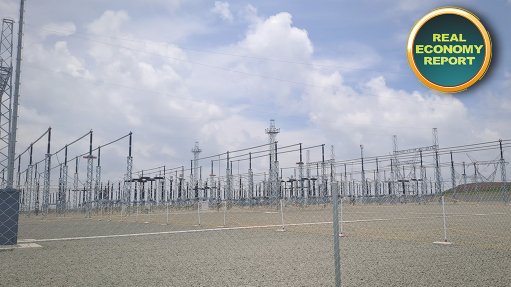Refurbishing a crane
Large cranes have many moving parts and quite complex systems. In general, travelling cranes supplied over the past 30 years have a driver who sat high up in a cabin.
In the cabin are the levers and controls that link the crane operating components, which are, but not limited to, the following: crane forward and aft travel; jib raise and lower; crane slew left or right; rope hoist. In general, the crane functions are driven by using hoists and pulleys and wire ropes, driven by electric motors. The motors used to be direct current but now are alternating current.
Owing to the nature of the crane functions, each of the motors has to get up to speed slowly – things go wrong if the motor starts and ramps to full speed quickly. Thus, the motors have to be fitted with a ‘soft start’ and ‘soft stop’ function. Historically, this was done with motors which had a wound rotor, with the winding connections brought out. This is not very common these days but that’s how they did it. The windings then are connected to a resistance box. When power is applied to the motor stator, the resistances are fully in circuit and the current in the rotor thus limited. The motor will turn slowly and then, as the resistances are shorted out (generally by a circuit connected to a driver’s control lever) the motor will speed up and drive the pulleys connected to the various wire ropes which control the crane. Up to eight such motors (or, exceptionally, more) are driven in this way. Now it happened that a crane of this type had fallen out of service. Some of the motors had burnt out, some of the resistance boxes had failed. And, not the least, the number of people who wanted to climb up to the crane cab and work there all day was diminishing.
Given the task of refurbishing the crane, the following was decided: no more would a crane driver sit in a cab full of levers. Instead, he would stand or sit in a small cabin next to the crane. The control of the crane would be by using a hand-held radio remote control box (in this case a device made by Scanreco). This control box would transmit signals to an interface box on the crane which would operate contactors supplying power to the various motors, through a variable-speed drive (VSD). The VSD would supply the necessary ramping up and down of motor speeds, and a further contact would allow the operator to set the motor to a ‘crawl’ mode. The resistors were scrapped and the motor rotor windings shorted out.
The result of the crane conversion was very satisfactory. The radio control unit was found to be very reliable and the operators found it easy to operate. No longer would the driver have to look down to where the load was, with the view obscured by wire ropes, steelwork and trusses. It was possible for the driver to look under the load and see how much clearance there still was so as to land the load accurately. ‘Walking’ a load was easy, as the driver was right there.
One thing that surprises me is that the use of radio control to interface with large machines is no more widespread. Using radio controls does away with a great deal of control wiring and subsystems. Typically, on a large tug or other vessel, much of the control is done with hardwiring from the bridge to a relay cabinet where the relay outputs interface with a hydraulic system used for steering control or engine management. The hardwiring itself is not a problem normally but, if there is a fire or local mechanical damage, it is very difficult to replace. Further, the use of levers to control hydraulic systems adds one more moving component to the system and this, inevitably, can fail. In the past, electromagnetic interference would have made a radio system unreliable but by coding and the use of selected frequencies, this is no longer the case. So, for a crane or hydraulic upgrade . . . try it.
Article Enquiry
Email Article
Save Article
Feedback
To advertise email advertising@creamermedia.co.za or click here
Comments
Press Office
Announcements
What's On
Subscribe to improve your user experience...
Option 1 (equivalent of R125 a month):
Receive a weekly copy of Creamer Media's Engineering News & Mining Weekly magazine
(print copy for those in South Africa and e-magazine for those outside of South Africa)
Receive daily email newsletters
Access to full search results
Access archive of magazine back copies
Access to Projects in Progress
Access to ONE Research Report of your choice in PDF format
Option 2 (equivalent of R375 a month):
All benefits from Option 1
PLUS
Access to Creamer Media's Research Channel Africa for ALL Research Reports, in PDF format, on various industrial and mining sectors
including Electricity; Water; Energy Transition; Hydrogen; Roads, Rail and Ports; Coal; Gold; Platinum; Battery Metals; etc.
Already a subscriber?
Forgotten your password?
Receive weekly copy of Creamer Media's Engineering News & Mining Weekly magazine (print copy for those in South Africa and e-magazine for those outside of South Africa)
➕
Recieve daily email newsletters
➕
Access to full search results
➕
Access archive of magazine back copies
➕
Access to Projects in Progress
➕
Access to ONE Research Report of your choice in PDF format
RESEARCH CHANNEL AFRICA
R4500 (equivalent of R375 a month)
SUBSCRIBEAll benefits from Option 1
➕
Access to Creamer Media's Research Channel Africa for ALL Research Reports on various industrial and mining sectors, in PDF format, including on:
Electricity
➕
Water
➕
Energy Transition
➕
Hydrogen
➕
Roads, Rail and Ports
➕
Coal
➕
Gold
➕
Platinum
➕
Battery Metals
➕
etc.
Receive all benefits from Option 1 or Option 2 delivered to numerous people at your company
➕
Multiple User names and Passwords for simultaneous log-ins
➕
Intranet integration access to all in your organisation

















